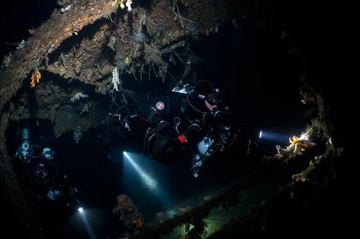You're enjoying a wonderful night dive. Pitch black, illuminated only by your flashlight, the world so quiet you can only hear your own breathing. Suddenly, a bright flash of light shines directly onto your mask, blinding you, leaving you pale and dizzy—this is called a "light burst."
We've all experienced this, and perhaps even inadvertently become that "annoying person." Underwater lighting is a tool for us to discover wonders, but when used improperly, it can become a weapon that disturbs others and harms creatures. Mastering underwater lighting etiquette is essential for being a considerate, professional, and popular diver.

Rule 1: Never shine directly into the eyes of others (buddies, instructors, or other divers).
This is the most important and fundamental golden rule of underwater lighting etiquette.
Why? Pupils dilate underwater to absorb more light. Sudden, intense light can cause temporary dazzle or even blindness, which is not only extremely uncomfortable but also poses a significant safety risk. Losing sight of your buddy, your computer, or your surroundings can lead to accidents.
What to do?
Always pay attention to the direction of your beam. When approaching others, subconsciously point your light in the opposite direction or toward the bottom of the water.
When communicating, shine your light on the other person's lower body or shoulders. This will attract their attention without directly shining into their visor. Imagine being on land. Would you shine a flashlight in someone's face or on their feet to signal "I'm here"?
When observing your buddy, use your peripheral vision. Your main beam should always be pointed directly in front of you, not scanning your buddy.

Rule 2: Treat Marine Life Gently
We are guests visiting, and we should respect the host's schedule.
Why? Many marine creatures have sensitive vision. Bright light can startle them, disrupt their natural behaviors (such as feeding and resting), and even damage the retinas of some tiny creatures.
How?
Avoid prolonged direct sunlight. This is especially true for nocturnal creatures (such as lobsters and crabs) and light-sensitive creatures (such as octopuses and moray eels).
Use diffused light or reduce the brightness. Many dive lights have a low-intensity setting, or you can move the light slightly away and observe with diffused light from the edges. This provides a softer, more natural-looking color.
Don't use light to "trap" or confine creatures. Don't use a beam of light to corner fish; it's extremely stressful for them.

Rule 3: When diving in a group, manage your "light pollution."
When a team includes multiple divers, the underwater light becomes extremely chaotic.
Why? Countless beams of light from different directions intersect and collide in the water, creating a dazzling display of light and shadows that obstructs everyone's observation and easily distracts attention.
How to do it?
Keep your light focused in front of you. Just like driving with low beams, illuminate the path you need to follow and avoid "sweeping" the entire group with your light.
When following a leader, avoid shining your light directly at them. Your light should be directed in front of or to the side of them, not on their back or head.
When visibility is acceptable, you can even temporarily turn off your light and admire the silhouettes of other divers' lights, which is a unique experience.

Rule 4: Use light signals for communication.
Light is a vital communication tool in the silent world of underwater.
Standard Signals (must be confirmed with your buddy before entering the water):
Circle (OK?/OK!): Use your light beam to draw a large circle within your buddy's line of sight, asking, "Are you okay?" or responding, "I'm fine."
Up and Down (Look Here/Attention): Use your light beam to wave up and down at a target to get your buddy's attention, meaning, "Look here!"
Side-to-Side (Warning/Danger/Problem): Rapidly wave your light beam side-to-side, usually indicating, "Something's wrong, stop," or "I've got a problem" that requires immediate attention.
Important Tip: When using any light signal, always shine it below your buddy's line of sight, not directly into their mirrors.

Rule 5: Self-Care for Photographers
Underwater photographers and videographers are often the most vulnerable to "light pollution" and need to be especially vigilant.
Why? Your light is often brighter and needs to be constantly on to find your target, making it more likely to distract others.
How to Do It?
Between shots, turn off or shield your video light. Don't keep your headlight constantly on and sweeping around.
When photographing a diver, make sure your light doesn't distract others in your group.
If others are photographing the same subject, politely negotiate and share the light, or find angles to avoid focusing all the light on one spot, which could result in a blown-out photo.
The core of underwater lighting etiquette comes down to four words: treat others the way you would like them to treat you.
Next time you go underwater, remember:
✅ Point the light downward for the utmost courtesy.
✅ Observe the creatures with gentleness and reserve.
✅ Work as a team to manage light pollution.
✅ Use signals wisely for safe communication.
Let us all be good divers who are both light-conscious and well-mannered, and together maintain harmony and enjoyment underwater. Do you have any other funny or embarrassing experiences with underwater lighting? Share them in the comments!






d6q2h2
d6q2h2